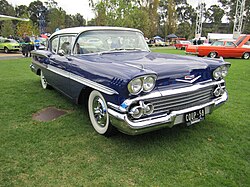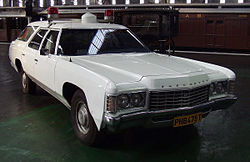Chevrolet Biscayne
| Chevrolet Biscayne | |
|---|---|
| Production period: | 1958-1972 |
| Class : | upper middle class |
| Body versions : | Limousine , station wagon , panel van |
| Previous model: | Chevrolet Two-Ten Series 2100 |
The Chevrolet Biscayne was an upper middle class passenger car that was built by Chevrolet in the USA from 1958 to 1972 as the successor to the Two-Ten model. In 1958 it was the mid-range trim level, but after the Del Ray was discontinued in 1959, it was Chevrolet's cheapest offer in its class.
Model history
Biscayne Series 1500 and 1600 (1958)
| 1st generation | |
|---|---|
|
Chevrolet Biscayne 2-Door Sedan (1958) |
|
| Production period: | 1958 |
| Body versions : | Limousine , station wagon |
| Engines: |
Petrol engines : 3.9-5.7 liters (107-232 kW) |
| Length: | 5311 mm |
| Width: | 1974 mm |
| Height: | 1458 mm |
| Wheelbase : | 2985 mm |
| Empty weight : | 1542-1739 kg |
In 1958 the Biscayne became the successor to the Two-Ten .
The six-cylinder models were called this series in 1500 and had known from the previous engine with 3859 cm 3 , the 145 hp (107 kW) at 4,200 min -1 gave. Six different V8 engines were available in the 1600 series ; Base was an engine with 4,638 cm 3 , the at 4,600 min -1 gave an output of 185 hp (136 kW). The following motors were also available in this series on request and at an additional cost:
| Type | Displacement | compression | Carburetor | Exhaust | power | at speed |
|---|---|---|---|---|---|---|
| [cm 3 ] | [:1] | [HP / kW] | [min −1 ] | |||
| Super Turbo-Fire V-8 | 4,638 | 9.5 | Fourfold | Easy | 230/169 | 4,800 |
| Turbo-Thrust V-8 | 5,703 | 9.5 | Fourfold | Double | 250/184 | 4,400 |
| Super Turbo Thrust V-8 | 5,703 | 9.5 | 3 × double | Double | 280/206 | 4,800 |
| Super Turbo Thrust V-8 | 5,703 | 11.0 | 3 × double | Double | 315/232 | 5,600 |
| Ram-Jet Fuel Injection V-8 | 4,638 | 9.5 | injection | Easy | 250/184 | 5,000 |
There were only two bodies for the Biscayne: sedans with six seats with two or four doors and the six- or nine-seat station wagons with five doors called Brookwood . Instead of the individual headlights of the previous model, there were now double headlights under the barges.
Biscayne Series 1100, 1200, 1300 and 1400 (1959-1964)
| 2nd generation | |
|---|---|
|
Chevrolet Biscayne Sedan (1959) |
|
| Production period: | 1959-1964 |
| Body versions : | Limousine , station wagon , panel van |
| Engines: |
Petrol engines : 3.9–7.0 liters (99–316 kW) |
| Length: | 5316-5357 mm |
| Width: | 2022-2029 mm |
| Height: | 1422-1430 mm |
| Wheelbase : | 3023 mm |
| Empty weight : | 1463-1792 kg |
The 1959 Chevrolets were completely revised. The significantly flatter bodies with a longer wheelbase had a radiator grille over the entire width of the vehicle with integrated double headlights and characteristic wing- shaped tail fins under which lens-shaped taillights were arranged. The Del Ray had disappeared, and so the Biscayne series 1100 (six-cylinder) and 1200 (V8) was the entry-level model. In addition to the two sedans from the previous year, there was now a two-door "utility sedan", a sedan without a back seat that served as a delivery van. The Brookwood was only available with six seats, but with either three or five doors.
The engine range from the previous year was largely taken over.
In 1960 there were significant stylistic changes to the body. New were the Fleetmaster series 1300 (six-cylinder) and 1400 (V8), two- or four-door sedans that had somewhat simpler equipment than the standard models and were intended for vehicle fleets. The upholstery was kept simpler, cigarette lighter, armrests in the doors and sun visor on the passenger side - otherwise part of the standard equipment - were missing on these models. Many otherwise chrome-plated parts of the Fleetmaster were just painted. The three-door Brookwood was no longer available, but there was again a nine-seater.
A facelift followed in 1961 , which left only hints of the rear wings. The engine range was expanded to include a V8 with a 6,702 cm 3 displacement and 360 hp (265 kW) output. The other units also increased in performance.
In 1962, the Chevy II was introduced in the lower middle class , so the Biscayne was no longer the smallest Chevrolet. The Fleetmaster models were no longer available, as was the “Utility Sedan”. The bodies were streamlined and the lens-shaped taillights gave way to three round ones on each side. The 6.7 liter V8 achieved a new record with 409 hp (301 kW). The station wagon was only available as a six-seater and was no longer called Brookwood, but, like the other models, Biscayne.
1963 there were mainly external stylistic changes, but also the engine power of the 6.7 liter V8 puts 425 hp (313 kW) and additionally to a V8 with 6,997 cm was 3 displacement and 430 hp (316 kW) available.
In 1964, as in previous years, the exterior was revised, especially at the front and rear, and featured a slightly lower radiator grille, among other things.
Biscayne Series 153 and 154 (1965-1970)
| 3rd generation | |
|---|---|
|
Chevrolet Biscayne Sedan (1965) |
|
| Production period: | 1965-1970 |
| Body versions : | Limousine , station wagon |
| Engines: |
Petrol engines : 3.9–7.0 liters (103–313 kW) |
| Length: | 5395-5512 mm |
| Width: | |
| Height: | |
| Wheelbase : | 3023 mm |
| Empty weight : | 1497-1904 kg |
The Biscayne was presented completely redesigned in the 1965 model year. The cars were flatter, wider and longer. The nose with the low grille, which also extended below the bumper, formed a shallow V with its syringe pointing forward and up. There was a slight hip bend over the rear wheel cutouts. In addition to the well-known six-cylinder in-line engine there was a new unit with 4,097 cm 3 capacity, which at 4,200 min -1 developed a power of 155 hp (114 kW). The six-cylinder models were now called the 153 series , while the V8 models were called the 154 series . For them, there was a new V8 with 6489 cm 3 , which carried 325 to 425 hp (239-313 kW). In the following year there were only minor retouching, such as additional chrome strips on the headlights.
In 1967 the front indicators moved to the corners of the vehicle and formed a clear contouring of the front of the vehicle with the V-shaped nose. The hip bends over the rear wheel arches became more noticeable.
In 1968 the front indicators became smaller again and made room for a front bumper that was clearly pulled upwards. The double headlights received rectangular, chrome-plated frames. Technically, little changed in these two years.
The series was completely revised again in 1969. With the same wheelbase, the cars had grown again in length and width. The even more strongly contoured front showed a solid chrome frame on all sides and the rear wheel cutouts had been reduced so much that the upper halves of the wheels were almost covered. The lower half of the rear end was taken up by the chrome-plated rear bumper, which also accommodated the three narrow taillights on each side. The station wagon was called Brookwood again.
There were few changes in 1970. The two-door sedan was stopped and tightened the engine program: In addition to the familiar 4.1-liter six-cylinder engine, a new V8 came with 5735 cm 3 displacement and 250 hp (184 kW).
Biscayne Series 153, 154 and 1K (1971–1972)
| 4th generation | |
|---|---|
|
Chevrolet Brookwood (1971) |
|
| Production period: | 1971-1972 |
| Body versions : | Limousine , station wagon |
| Engines: |
Gasoline engines : 4.1–7.4 liters (81–199 kW) |
| Length: | 5512-5740 mm |
| Width: | |
| Height: | |
| Wheelbase : | 3086-3175 mm |
| Empty weight : | 1691-2123 kg |
In 1971 a completely new Biscayne came out. The station wagon was still called Brookwood. The wheelbase of the sedan had grown by 2 ½ ", and the station wagon by 6". The massive, strongly contoured front featured a low radiator grille and indicators again on the corners of the vehicle. All big Chevrolets got disc brakes on all four wheels. The engine power sank by 5 bhp each.
A slight redesign of the front of the vehicle made the radiator grille shrink in height in 1972. The wheelbase of the limousine increased again by ½ ". From this year on, the engine performance was given in net horsepower (nhp). The most powerful V8 engine had 7,440 cm 3 Displacement and made 270 hp (199 kW). The new model designation was uniform for the six and eight-cylinder 1K series last year
In the following year, the Biscayne was no longer offered and the Bel Air took over the role of the cheapest Chevrolet in the upper middle class. A Biscayne with a 5.7 liter V8 was offered in Canada until 1975.
Web links
literature
- John Gunnell (Ed.): Standard Catalog of American Cars, 1946-1975. Revised 4th edition. Krause Publications Inc., Iola WI 2002, ISBN 0-87349-461-X .







